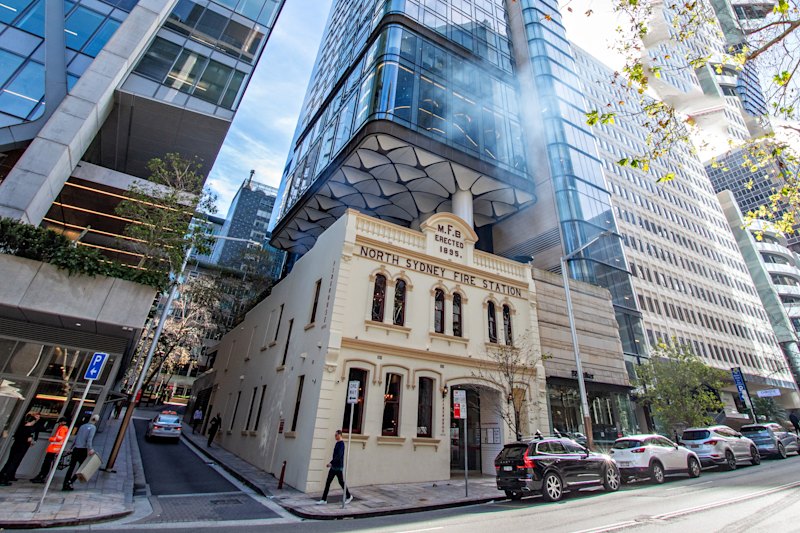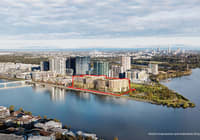
The pros and cons of investing in medical facilities
If you’re thinking about investing in a medical centre, you’re not alone.
There’s growing interest among new buyers in Australia’s “recession-proof” commercial healthcare real estate. Currently worth about $25 billion, the Australian medical sector is considered an attractive investment option due to global healthcare trends, industry stability, attractive returns, technological innovation, resilient demand, long leases, lower vacancy rates, and, importantly, increased government funding. And it’s bracing for growth over the next two decades.
The resilience and stability of the sector have attracted a wider array of buyers keen to diversify their portfolios – beyond typical core assets of retail and office – due to Australia’s ageing population, longer life expectancy, increases in chronic diseases such as diabetes, population growth, and a drive towards preventative care.
These new entrants join seasoned investors such as real estate investment trusts (REITs), private investors and syndicates in recently pouncing on increased stock volumes to the tune of $50 million, a CBRE report into the healthcare industry reveals.
Other investors in healthcare include owner-occupiers who buy into the asset class as a physician or specialist developing a new practice or by acquiring an established business. With expensive fitouts, this provides their businesses with long-term security, with a loan-to-value ratio from lenders up to 100 per cent or more.
Like a beating heart is integral to life, healthcare providers offer essential services for every member of the community, whether urban or rural, in a clinic, medical centre, or medical precinct. Profitability can be based on factors such as location, management and market conditions. Areas with limited access to healthcare services often present prime investment opportunities for new medical centres.
Whether you need help getting over the flu, treating asthma, getting immunisations or relieving arthritis, GPs, specialists, and allied health providers offer, among many services, acute and non-acute care, pain management and help steer long-term wellness.
What is a medical centre investment?
In Australia, a medical centre is somewhere a patient goes to seek healthcare advice, such as a diagnosis, treatment or preventative care. Medical centres are often larger facilities that offer a wide array of services to meet the healthcare needs of a community, whereas clinics tend to be smaller and offer more specialised services. There is a growing trend born out of the US towards medical precincts that are larger than medical centres and offer a multidisciplinary approach with better continuity of care for patients.
The most common type of medical centre is that of your local general practitioner, a place that offers routine checkups, vaccinations, and everything else in between. Others include urgent care – for non-life threatening help often outside of hours and specialist clinics – such as day surgeries, women’s health, psychologists, dermatologists and paediatricians and allied health outlets for physiotherapy and osteopathy.
The benefits of operating in a medical centre include close proximity to other medical professionals, higher foot traffic of people who need medical support, and potential referrals for allied health operators from GPs within the centre. However, a clinic can provide a better street presence with more signage opportunities, as well as more flexible expansion opportunities through extensions and renovations of the building.
Public hospitals account for 54.7 per cent of Australia’s healthcare sector, followed by medical services at 20.4 per cent, allied health services at 9.7 per cent, pathology and diagnostic services at 5.3 per cent, and other health services at 9.9 per cent, IBIS data shows.
Healthcare services are in demand – and aren’t slowing down
In Australia, strong demand for medical services tends to prevail even during tough economic conditions, with many operators rapidly growing to help meet demand since the COVID-19 pandemic. A dynamic investment environment exists due to the nation’s ageing and growing population, shifts in healthcare delivery models to outpatient care and the expansion of telehealth services, as well as government support through policy initiatives prioritising healthcare and subsidies and programs like Medicare.
Over the past year, state and federal governments have thrown millions of dollars towards healthcare to improve infrastructure and operations, along with some $50 million in private investment entering the sector thanks to an increase in stock volumes translating to heightened market awareness. In 2022, The University of Sydney announced its largest-ever capital investment, a landmark $478 million, to build a nation-leading biomedical precinct to fast-track research and patient care in NSW.
However, Sandro Peluso, director of healthcare and social infrastructure at CBRE, said the healthcare sector still desperately needed more private investment to keep up with projected demand.
“While there have been some short-term headwinds for the sector that have softened entry prices for investment, the long-term viability of the sector isn’t in question as the tightly held nature of assets in this market continues to make investment highly compelling,” he said.
“There will always be a need for healthcare real estate for surgical procedures, physical examinations, and imagery services. The public healthcare system simply cannot handle the forthcoming surge in demand we are going to see over the next 15 years without private support, so this will continue to drive investment in the sector.”
Investors looking to buy into a “recession-proof” healthcare sector – unaffected by business cycles or consumer demand – will find the essential service of medical centres a welcome change that can serve as a buffer against volatility in other sectors, enhancing portfolio diversification and mitigating risk, as seen in the bidding war between local, interstate and offshore buyers for a Bentleigh East medical clinic. Meanwhile, patients will prioritise their hard-earned cash on health while pulling back on discretionary spending.
Right now, the demand for health services outstrips supply, with long wait lists and costly bills for specialist appointments. Hospitals are overrun, with a high turnover of patients to enhance profitability.
Andrew Hemming, managing director of Centuria Healthcare, said there was an industry shift towards moving patients out of hospitals and into primary and secondary care facilities, with overrun emergency departments in need of solutions. He highlighted the importance of a multidisciplinary approach considering the entire healthcare chain, whether in a single building or across multiple locations, for continuity of care, including diagnostics, pathology, pharmacy, and education or accommodation. Capitalisation rates for investment-grade medical centres in metro markets remain around 6 per cent, down from 4.5 per cent pre-pandemic, with regional markets seeing rates of 6.5 per cent to 7 per cent, he added.
However, with public hospitals clogged up with heightened demand and staff shortages, Australia’s $22 billion private hospital sector has been shaken up, with closures due to rising costs and difficulties with insurance partners. A number of private hospitals have closed in recent times due to financial difficulty, and building costs have skyrocketed due to inflation, making new medical developments a costly enterprise.
Benefits of investing in medical centres
Stable income
If you’ve done your research, expect a relatively stable and predictable income stream without riding the volatile ups and downs of the retail, tourism and hospitality sectors.
Healthcare providers at medical centres commonly sign long-term leases between five and seven years, with some up to 15 years. Typical lease terms at private hospitals are between 20 to 30 years. This commitment provides landlords with predictable rental income and lower vacancy rates and helps medical professionals establish a solid clientele after coughing up for an expensive fitout, which can cost between $5 million and $10 million for a GP with 10 consulting rooms.
Seen as reliable tenants, doctors are looked upon favourably by lenders with lower risk of default due to their stable incomes. In 2024, doctors in Australia can earn an average of $157,665 per year, according to figures from Talent.com. Those in entry-level positions can expect to make $121,211, while most experienced doctors take home up to $296,400 per year.
Loyal patients also contribute to stable rent, bolstered by the financial backing of government-funded Medicare, which subsidises a patient’s outlay. The federal and state governments fund more than 70 per cent of health expenditure in Australia, according to the Australian Institute of Health and Welfare (AIHW).
Growing demand due to population ageing and health trends
The nation’s largest and fastest-growing industry, accounting for 8 per cent of the Australian economy and 16 per cent of employment, is the healthcare and social assistance industry, according to the Australian Bureau of Statistics (ABS).
As previously mentioned, the population is ageing, with life expectancy increases and declining fertility rates to blame. By 2066, projections anticipate older people will make up between 21 and 23 per cent of Australia’s total population, up from 0.5 per cent in 1970 to 2.1 per cent in 2020, ABS data shows.
Thanks to medical technological innovation, the average life expectancy for men is 81 years and 85 for women, up from 78 and 83 years just 20 years ago. However, while people live longer, the need for care increases as health diminishes.
Lifestyle factors have led to a rapid rise in the prevalence of chronic disease and obesity, driving higher demand for hospital beds. As an example, the Property Council of Australia found that to meet population demands, south-east Queensland will need at least 20 new hospitals by 2046, along with 70 new medical centres and 11 mental health care facilities.
As touched on earlier, Hemming elaborated on the global healthcare trend toward reduced hospital stays, highlighting the need for outpatient care and integrated primary care, or multidisciplinary models, as well as more urgent care clinics. This multidisciplinary medical model can be likened to paying for a subscription streaming service, which is already off and away in the United States and parts of Europe, with healthcare organisations Kaiser Permanente and One Medical offering custom care annual medical subscriptions across the United States. They cover a range of medical services, with add-ons you can purchase, much like adding sports or movies to a general streaming subscription.
In Australia, Hemming said initiatives from private health insurers My Health and Bupa were adopting similar models to allow patients to have their healthcare journey in one setting, which are expected to come to fruition in the next five to 10 years. These centres are bigger and less clinical, but they are more like homes in their design and features.
“Bupa has said it will spend about $100 million on new primary care medical centres. It’s their financial imperative to ensure patients have better care – or more longitudinal care, managed care – to slow down the rate of throughput into the hospital because that’s where a lot of their funding is spent. If they can slow that down, obviously they make more money. And the thing is, it’s a better healthcare outcome for the patient.”
“If a patient is to spend less time in a hospital, they will then need to go to an outpatient care setting. Now, that will usually involve primary care and specialist care. So, it’ll involve a GP and then a specialist doctor … a multidisciplinary approach to health care,” he said.
“What healthcare precincts do is they bring the chain together in terms of that collaboration through referral partners or referral networks. There’s a lot of business efficiency and financial alignment between having them all co-located.”
Healthcare investments show economic resilience
Unlike discretionary spending, which is impacted during economic downturns, patients will spend or rely on Medicare to stay on the treadmill of life.
During the COVID-19 pandemic, when most services were shut down, Australia’s healthcare industry recorded its weakest financial performance. However, by embracing innovation and moving to telehealth amid strong demand, it bounced back much quicker than the broader economy’s GDP.
This was in part due to vacant offices and mixed-use buildings being sold or leased as medical and allied health premises as a way of maximising returns in the post-pandemic era.
After the pandemic, health precincts were among the most in-demand commercial assets in the world, with the market growing exponentially in Australia as quality healthcare reached the top of every political agenda post-lockdown.
The sector is also supported by a strong historical performance, having remained resilient during past economic downturns, including the Global Financial Crisis (GFC) from 2007 to 2009.
Before the GFC in 2007, capitalisation rates for healthcare assets were approximately 100 basis points lower than those for industrial assets and at least 200 basis points higher than retail and office properties. Fast forward 13 years, and average healthcare capitalisation rates have reached 6 per cent and outperform office properties by 50 to 100 basis points, CBRE data shows.
It’s essential to do your research and consult with industry experts before making a decision.
Community impact
An investment into healthcare via this asset class will provide a positive contribution to local communities and their ability to access healthcare.
Community ties are strengthened by these hubs, where health and wellbeing are paramount. Connectedness is enhanced by the offering of local initiatives, wellbeing programs, and health awareness campaigns. A medical centre’s success often hinges on its location, and areas with higher population density connected to public transport can see more patients through their doors.
However, rural medical centres, which have lower patient volumes and transportation barriers, can also be profitable investments due to less competition, higher community demand with higher patient loyalty and repeat visits, and lower operating costs. They also benefit from government support with incentives and funding programs aimed at improving remote access, as well as the two-way benefit of long-term relationships between doctors and patients, which adds to continuity of care and a greater sense of community, a topic long explored on screen, more recently in the Netflix series Virgin River, and in the ’80s Australian TV series, A Country Practice.
Risks and considerations
Complex regulatory challenges and compliance
One of the biggest barriers to investing in the asset class is the daunting nature of healthcare regulations and ongoing compliance, with patient privacy leaks resulting in significant fines.
The nation’s heavily regulated healthcare system is not for the faint of heart. To ensure operational success, it’s important to get your head around the following:
- State and federal licensing requirements, including practitioner registration with the Australian Health Practitioner Regulation Agency
- Facility accreditation through the Australian Commission on Safety and Quality in Health Care
- Building and zoning codes
- Privacy and data protection – ensure health records align with the Privacy Act 1988 and get on top of cybersecurity
- Employment and labour laws, including workplace regulations according to the Fair Work Act 2009 and staff training and certification
- Medicare compliance and tax obligations, such as the Goods and Services Tax
- Clinical governance, such as quality improvement and incident reporting
- Environmental regulations such as waste management of hazardous materials
We recommend doing your research and consulting with financial and legal experts before jumping in head first.
High initial costs to acquire or develop medical properties
Costs are high initially when acquiring or developing medical properties.
Buyers will pay for construction expenses and install a suitable fitout that meets healthcare standards and compliance requirements. Costs of fitouts vary depending on the services offered but can range between $500,000 for smaller GP practices to $20 million for hospitals, Hemming estimates.
An investor will pay between hundreds of thousands to several million dollars depending on size, location and facility type. Acquiring a medical facility ready-to-go might cost between $6 million to $30 million, with the recently finished Coffs Harbour Specialist Medical Centre representing the top end of the property value range, with three levels of lettable space and rent, including an incentive.
Ongoing operational outlays to cover staffing, utilities, equipment and maintenance can also be high. Investors will need adequate financial resources to cover these costs during the early stages. Detailed business plans will be needed to attract lenders who are less willing to approve loans due to the specific nature of healthcare buy-ins.
Market competition can affect profits
Like with any investment, profitability and customer patronage of medical property are affected by local competition, with suburban and city locales particularly affected when another health precinct is located nearby. If the opposition has newer facilities or offers a better service, it might be time to reevaluate the practice’s offerings. It’s important to stay ahead of the game and embrace emerging trends, as seen in the adaptation to online bookings and telehealth, to ensure your service shifts alongside customer preferences.
Managing relationships with tenants
Managing relationships with healthcare professionals is paramount to success, as this leads to fewer retention challenges and less need for conflict resolution.
Like with any tenanted investment, happy leaseholders stay longer, leading to steady rental income. By keeping the basics ticking along, like providing decent facilities and creating a positive environment, healthcare professionals will feel valued and stay put. However, issues can arise over the way things are run, how space is divided up, and over lease terms, so ensure clear communication and effective tools to facilitate conflict resolution are in place.
If acquiring an established practice, challenges include long-term staff who may present with compromised work habits. Employees come with contracts and liabilities you will take over, including sick leave, annual leave and long-service leave. If the medical facility’s reputation is not favourable, there will be a need to rebrand and relaunch. An older medical practice may come with old equipment, decor or outdated computing systems. And some staff may not welcome changes you want to initiate.
However, if taking over an established business, benefits include being able to hit the ground running with a busy practice and customer base, loyal staff at the ready, taking over an established reputation – and its goodwill, which means less need for marketing.
Should a tenant vacate, an owner may face retention challenges as medical tenants are harder to replace, given there’s a smaller pool of them compared with office or retail tenants. It can mean higher vacancy rates, and your investment could be devalued if a medical tenant is replaced with a non-medical tenant. However, due to the high cost of fitting out a medical facility, tenants will stay longer to earn back their investment capital, which will provide more surety to the lease.










